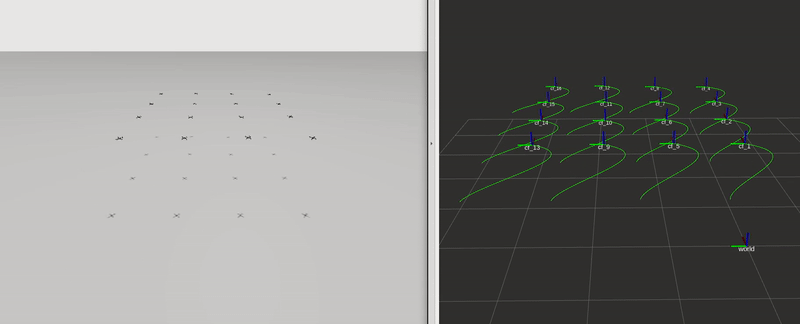This code accompanies the work in the ICRA 2024 submission "CrazySim: A Software-in-the-Loop Simulator for Nano Quadcopter Fleets".
This simulator is currently only supported on Ubuntu systems with at least 20.04. This is primarily a requirement from Gazebo Sim. The simulator was built, tested, and verified on 22.04 with Gazebo Garden.
To install this repository use the recursive command as shown below for HTTPS:
git clone https://github.com/gtfactslab/Llanes_ICRA2024.git --recursivecd crazyflie-lib-python
pip install -e .The installation instructions and usage are referenced in the documentation file.
Install dependencies using the code below.
pip install Jinja2First install Gazebo Garden from https://gazebosim.org/docs/garden/install_ubuntu
Run the command to build the firmware and Gazebo plugins.
cd crazyflie-firmware
mkdir -p sitl_make/build && cd $_
cmake ..
make allMake sure you have ROS 2 Humble.
Install the following for Crazyswarm2:
sudo apt install libboost-program-options-dev libusb-1.0-0-dev
pip3 install rowan transforms3d
sudo apt install ros-humble-tf-transformationsIf you want to run the MPC code then you will need Acados. Acados can be installed by following their documentation.
Then build the ROS 2 workspace.
cd ros2_ws
colcon build --symlink-installThe crazyswarm2 configuration files can be found in
ros2_ws/src/crazyswarm2/crazyflie/config/The crazyflies.yaml describes the robots currently being used. If a robot is not in the simulator or hardware, then it can be disabled by setting the enabled parameter to false. A more detailed description for crazyswarm2 configurations can be found here.
The main code for the MPC script is in the following:
ros2_ws/crazyflie_mpc/crazyflie_mpc/crazyflie_multiagent_mpc.pyThe trajectory type can be changed to a horizontal circle, vertical circle, helix, or a lemniscate trajectory by changing the variable "trajectory_type" in the CrazyflieMPC class.
Currently, users have to restart Gazebo after each CFLib connect and disconnect cycle. Supporting a restart cycle without restarting Gazebo is on the list of things to do.
Open a terminal and run
cd crazyflie-firmwareWe can then run the firmware instance and spawn the models with Gazebo using a single launch script.
bash tools/crazyflie-simulation/simulator_files/gazebo/launch/sitl_singleagent.sh -m crazyflie -x 0 -y 0bash tools/crazyflie-simulation/simulator_files/gazebo/launch/sitl_multiagent_square.sh -n 8 -m crazyflieOption 3: Spawning multiple crazyflie models with positions defined in the agents.txt file. New vehicles are defined by adding a new line with comma deliminated initial position x,y.
bash tools/crazyflie-simulation/simulator_files/gazebo/launch/sitl_multiagent_text.sh -m crazyflieLaunch the Crazyswarm2 services with CFLib backend.
ros2 launch crazyflie launch.py backend:=cflibRun the Crazyflie MPC demonstration with the code below. The argument n_agents can be modified for the number of agents in your environment.
ros2 run crazyflie_mpc crazyflie_multiagent_mpc --n_agents=1Using the command line publisher we can command all vehicles to take off using MPC.
ros2 topic pub -t 50 -r 50 /all/mpc_takeoff std_msgs/msg/EmptyUsing the command line publisher we can command all vehicles to start the trajectory.
ros2 topic pub -t 50 -r 50 /all/mpc_trajectory std_msgs/msg/EmptyUsing the command line publisher we can command all vehicles to stop the trajectory and hover.
ros2 topic pub -t 50 -r 50 /all/mpc_hover std_msgs/msg/EmptyWe also implemented a MPC land feature, but it's still experimental and may result in crashing the drone.
